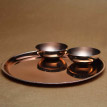In the mid-20th century, stainless steel replaces copper and its alloys because it
requires no maintenance and is corrosion-resistant. Moreover, the metal is recyclable
and so local stores regularly exchange old wares for new ones – a bargain much loved
by thrifty Indians. The market is protected from global competitiveness, which means
designs are simple and standardised with innovation occurring at the level of
manufacturing itself.
Products of industrialisation, these utensils explicitly break away from the older
material culture and its accompanying social practices. Similar to reinforced concrete’s
role in architecture, stainless steel signifies modernity in the domesticscape.
As the times will change, under the License Raj, middle classes will emulate the West
and aspire to own fashionable plasticware. Stainless steel will still remain in the Indian
kitchen - but no longer considered display-worthy, it will be reserved for backend
chores and for the use of household staff.
In the 21st century, as trends pirouette once again, interest in stainless steel will be
renewed - this time, for its excellent durability and slick finish.
Stainless Steel Idli Plate, Filter Coffee-maker
Designer: Unknown
Year: Unknown
 |
Stainless Steel Lacquered Thali, Katoris and Glasses Designer: Design Temple Year: 2006 The displayed dinner set is fashioned from stainless steel and finished with copper lacquer. The underside is powder-coated in orange. |



